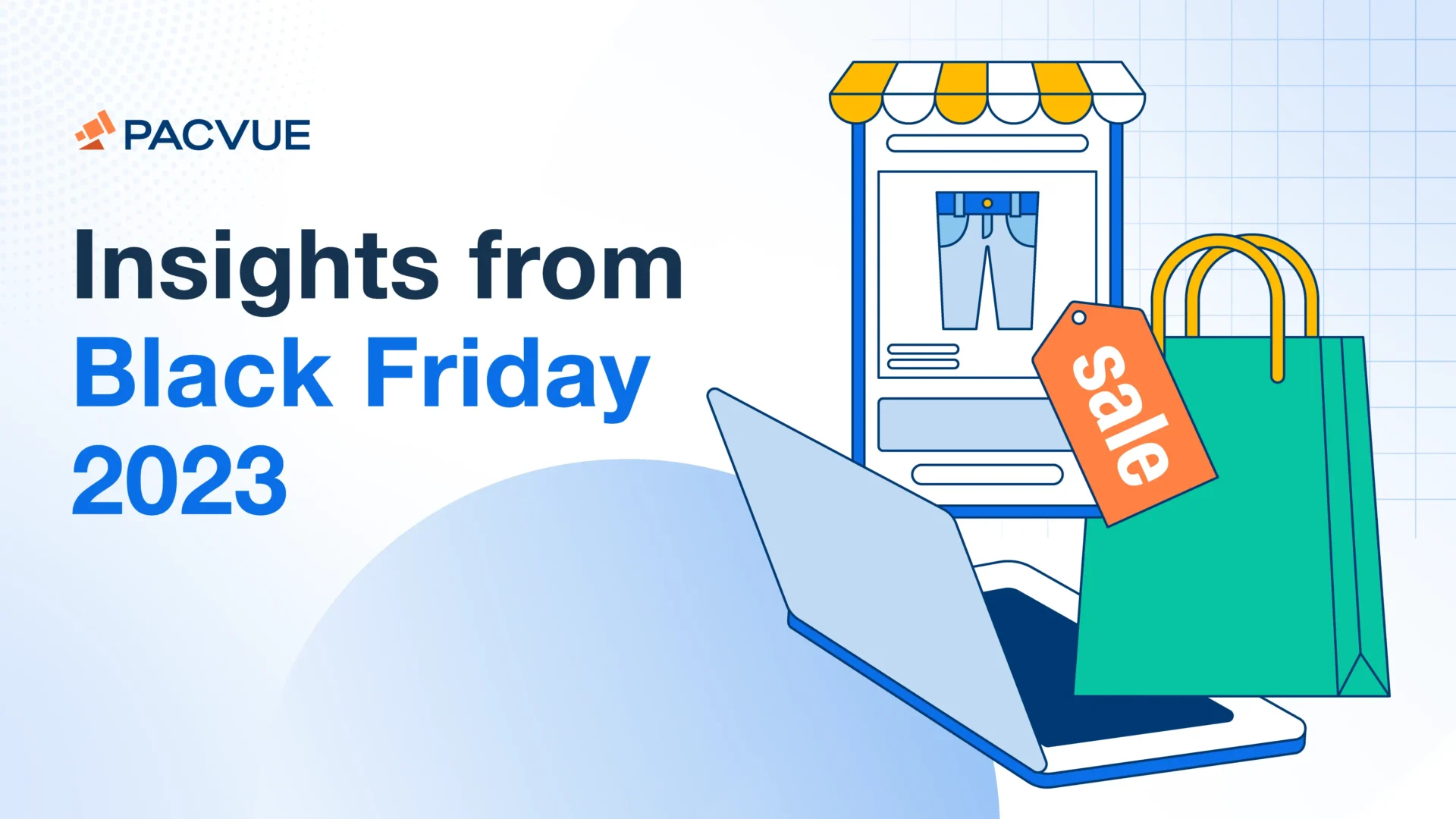The turkey has been devoured, the games have concluded, and a new era of Black Friday is upon us. Gone are the days of braving the early morning chill and camping outside stores for Black Friday deals. The era of in-person bargain hunting has transformed into a more convenient and digital experience, all from the comfort of one’s home.
This transformation has not only influenced how consumers shop but also prompted changes in retail strategies. These strategies propelled sales across the board, with Adobe reporting a record-breaking Black Friday sales event with $9.8 billion in sales, marking a 7.5% increase from the previous year. Let’s break down the Black Friday 2023 performance.
Black Friday Key Takeaways
- Advertising costs for Sponsored Brands placements saw a notable surge, rising by 17% from 2022. In contrast, costs for Sponsored Products saw a more modest increase of 4%. Overall, there was a general uptick in costs in the days leading up to Black Friday compared to last year.
- Advertisers spent, on average, 55% more on Sponsored Products and 61% more on Sponsored Brands compared to 2022. Black Friday saw dramatic increases in ad spend between Thursday and Friday, up between 80-90% day-over-day for both placement types.
- Despite increased spend, directional conversion rates indicate that ad conversion was lower this year than in 2022 for Sponsored Products, down 5.1% and Sponsored Brands placements down 3.8% from last year. This could be the result of higher prices due to inflation and consumers holding out to see if better deals arise during Cyber Monday.
- DSP saw a decrease in spend for Black Friday and a 10% drop in eCPM compared to 2022, indicating that advertisers are shifting their DSP spend strategies to prioritize the lead up and lead out.
Let’s examine some of the data points and trends observed during Black Friday 2023.
Advertising Costs and Competitiveness
Advertising competitiveness CPC for Sponsored Brands was relatively stable on Black Friday, with CPC only increasing 4% from 2022 and 11% from the previous day. Brands seemed to favor ad spend in the lead-up to Black Friday, with competitiveness up on average 24% year over year in the seven days prior to the Friday sale.
Brands were competing heavily for Sponsored Brands placements, with CPC up 17% year over year, taking costs 30% above those for Sponsored Products. This indicates a shift in advertisers’ strategies to favor Sponsored Brands placements for tentpole events.
Return on Advertising Spend
As of Monday advertisers saw a dip in Return on Ad Spend (ROAS) this Black Friday, but these numbers are likely to shift as more data comes in. Early results show Sponsored Products were hit hardest this year, with ROAS dipping by 34% from 2022, down to below the five-dollar mark. Sponsored Brands followed a similar trend, declining 27% year-over-year to just below four dollars and fifty cents. While brands spent more than ever this Black Friday to combat rising advertising costs, higher CPCs and lower conversion rates caused ROAS to take a hit this Black Friday, with lower ROAS coming in –14% lower than the July Prime Day event. Overall ROAS remained relatively flat week-over-week, increasing 4% for Sponsored Products and 10% for Sponsored Brands.
Advertising Spend
Advertising spend reached new highs this year, suggesting that brands were anticipating higher CPCs for Black Friday which did not materialize. Sponsored Products ad spend averages were up 55% year-over-year, and even bigger increases were seen for Sponsored Brand Ads, up 61% from 2022.
Advertisers bet big on Black Friday, with Sponsored Products ad spend increasing 91% and Sponsored Brands spend up 82% day over day from Thursday.
Advertisers effectively used Dayparting to manage budget distribution throughout the day and it paid off. Advertisers prioritized spend between 7-10 am PST on Black Friday, which aligned to the sales peak between 7-8 am PST. Conversion saw a steady decline as the day progressed despite spend increasing between 5-6 pm PST, indicating shoppers favored snagging morning deals.
Conversion Rates
The directional trend for conversion rates shows a downward trend for both Sponsored Products and Sponsored Brands compared to 2022. While we still await the full attribution report from the 14-day lookback window, the results indicate that Sponsored Products (17.37% conversion) narrowly outperformed Sponsored Brands (16.95%) on Black Friday and in the week leading up to the event. Check back in next week once we have data from the full lookback window, as conversion trends may shift.
DSP
DSP ad spend, on average, stayed consistent compared to the prior day, with a –15% reduction in average Black Friday spend compared to the prior year. This did result in lower average DSP-attributed sales for Black Friday so far (-25%), though sales were up +64% from Thanksgiving. We expect the year-over-year numbers will level out once we’re through the full attribution window for display. CPMs did increase on Black Friday compared to the average for Thanksgiving and the lead-up as competition increased into the peak of the tentpole period, though surprisingly, CPMs remained –10% below the average for the previous year – again marking a shift in how advertisers are utilizing DSP tactics for promo pushes.
New Ad Formats
For the first time, Amazon aired an NFL game on Black Friday. While sponsored TV ads are not groundbreaking, Amazon is innovating in how it approaches advertising. Specifically, Amazon is utilizing “audience-based creative,” enabling tailored messaging and actions for different audience segments within the same time slot. This utilizes first-party customer data for precise targeting. This approach enables brands to engage with viewers interested in specific product categories or content types available on Amazon, increasing relevance and capturing potential customers. As our Co-Founder and President, Melissa Burdick, highlights, “In an environment where every advertising dollar is scrutinized, this will be a highly measurable win for brands.”
Amazon’s cost-effective advertising, combined with measurable outcomes, has the potential to attract a broad range of advertisers, extending beyond traditional big brands. This approach allows for a direct correlation between ad spend and actual sales, presenting an appealing proposition for marketers across diverse industry verticals. As Burdick notes, “What’s most impressive is Amazon’s ability to hyper-target and display ads based on a customer’s search history — truly a marketer’s dream.” Positioned as a potential game-changer for digitally influenced sales, the streaming format of the game during Black Friday offers a unique opportunity for real-time advertising impact on shoppers, both online and in physical stores.
Final Thoughts
Overall, brands were not shy about their ad investments this Black Friday, boasting the highest ad spend in the past three years. There was a noticeable strategic shift in how brands allocated their ad budgets during the lead-up, with a consistent uptick in spending this year across sponsored placements and DSP.
The introduction of new product offerings for Sponsored Brands Placements, such as Brand Videos and Product Collections, prompted advertisers to increase their spending on this ad type. Black Friday 2023 witnessed the debut of Sponsored TV Ads, and while results are still pending, there is anticipation that more brands will capitalize on this innovative, hyper-targeted format.
Be sure to stay connected with Pacvue on LinkedIn as we publish more data and insights from Cyber-5.













